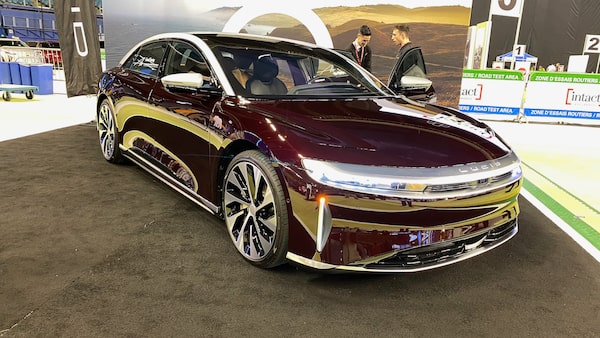
The Lucid Air on display at the 2023 Montreal Electric Vehicle Show.Michael Bettencourt/The Globe and Mail
The Lucid Air is a $120,000 escape from reality.
Here is a car – it feels like a spaceship – that avoids all the usual compromises drivers are forced to accept. It’s scary fast, yet supremely soft and comfortable. It feels highly original, but also intuitive and easy to use. It drives and handles like nothing else, better than most sports cars, and yet the trunk is cavernous and the rear seats offer limo-like space for relaxation. Not only that, it burns no fossil fuel; it’s an anxiety-free electric vehicle, able to cover 830 kilometres between charging stops.
Objectively, the Lucid Air is spectacular. But I’m getting tired of spectacular EVs with six-figure price tags. It’s been done. It’s too easy. Show me a great $30,000 EV with a clever design and long-range battery. Show me a Ford Model T or Volkswagen Beetle for the electric age. YES! Now that would be a breakthrough.
Even the bargain-basement versions of Rivian’s R1S SUV and R1T pickup cost at least $110,000. If you want the quad-motor model with the bigger battery and some optional luxuries, you’re talking $140,000. That’s also about the price of both Porsche’s Taycan and Tesla’s much-hyped Model S Plaid. The top-end electric Porsche is a wonderful, supercar-crushing, performance-enhanced station wagon that’ll set you back $259,000.
Prices on the Lucid Air are even more ridiculous. The Grand Touring model, which I drove recently, is the one with the headline-grabbing range of 830 kilometres, but it costs more than $200,000. The Lucid Air Sapphire, which packs 1,200 horsepower and can outrun anything this side of an air-to-air missile, costs more than $300,000.
Rolls-Royce has yet to announce a price for its first EV, Spectre, but unless your watch costs more than a compact car, forget about it. And we haven’t even gotten into the world of multimillion-dollar EV exotica, where the likes of the Rimac Nevera and Pininfarina Battista reside.
It’s not just the luxury brands charging outrageous money for EVs either. Chevrolet’s upcoming Silverado RST First Edition pickup will have 754 horsepower and a sticker price of $122,000. Let’s not even mention the gargantuan Hummer EV.
To put some of these prices in perspective, the median after-tax income of Canadian families and unattached individuals was $66,800 in 2020, according to Statistics Canada. The average asking price for new vehicles on Autotrader’s online marketplace was $61,821 through the first quarter of this year. (The company didn’t have data available on the average asking price of a new EV, but I’ll hazard a guess it’s about the same or more.)
Although still near a peak, interest in EVs declined recently, as consumers face rising interest rates and lower gas prices. Searches for EVs on Autotrader’s marketplace fell 32 per cent in March 2023, compared with the same month last year. “The top factors impacting declining interest among those not considering EVs are vehicle prices, interest rates and inflation,” a survey by the company found. In other words, money, money, money.
A recent Abacus poll found that six in 10 Canadians think an EV would be cheaper in the long run, but the higher up-front costs are still clearly a barrier for many people.
Six-figure EVs may once have been useful to get drivers excited about battery power. Today, those machines serve more as cash-grabs or PR stunts than a genuine attempt to get EVs into the hands of as many drivers as possible.
Rivian’s company page explains that, “to build the kind of future our kids and our kids’ kids deserve, extraordinary steps must be taken to stop the carbonization of our atmosphere.” Selling a handful of luxury trucks to wealthy drivers does not, I think, count as an extraordinary step.
Lucid’s mission statement says, “At Lucid, we believe in the dream ahead. Our relentless focus on innovation, luxury and sustainability moves us toward a future where you no longer have to choose between doing great things and doing the right thing.”
As wonderful as the Lucid Air is, it’s not clear how “doing the right thing” involves buying a $200,000 car, even if it is electric.
To be clear, I’m happy the Lucids, Rivians and Porsche Taycans of the world exist, but let’s not pretend they’re solving any problem other than alleviating some upper-class climate guilt.
The right thing, the thing that might help our kids’ kids – aside from massive investments in convenient, functional public transit – is not more venture-capital-funded luxury EVs, but a mass-market smash hit.
Some car companies are getting tantalizingly close, but we’re not there yet. The Tesla Model 3, even after recent price cuts, is still $50,000 after the federal rebate. The Hyundai Kona, Kia Niro, Volkswagen ID.4 and Chevrolet Bolt all cost in the $40,000 range, before the $5,000 federal rebate, and all of them offer at least 400 kilometres of range. Competent as they are, though, they’re hardly disruptive.
Cheap, long-range EVs aren’t impossible, they’re just small. At the recent Shanghai auto show, the new BYD Seagull drew the largest crowds. It seats four, has a range of 300 or 400 kilometres, and costs 78,000 yuan ($15,250). It looks good, too. China’s popular Wuling Mini EV has already notched up more than one million sales since July, 2020. It costs about $6,000 and is apparently popular with young people.
If only Canadians were interested in small cars, we may have a truly disruptive solution. As we watch a parade of six-figure EVs glide past, it’s worth remembering that, spectacular as they are, they won’t do much to solve the climate crisis.